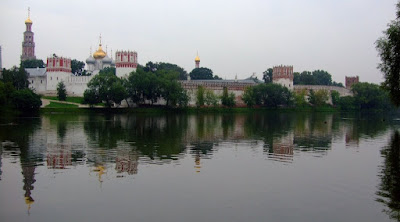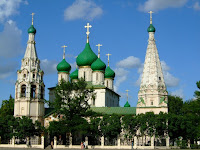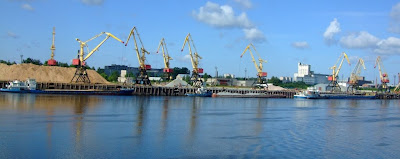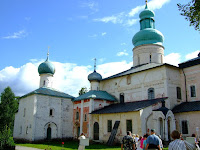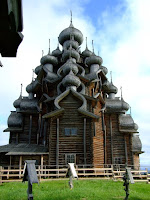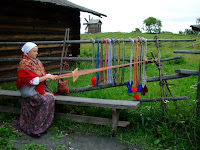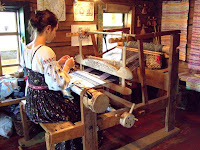 A tour of the Kremlin was the last scheduled tour of the trip, this morning, with an optional add-on to visit the Armoury Museum. While there is some armour there, the museum has much else to offer - 10 Faberge Eggs, a dozen or so State coaches and sledges, a stunning collection of Ambassadorial gifts and many religious themed treasures like icon covers, jewel encrusted Bible covers and so forth.
A tour of the Kremlin was the last scheduled tour of the trip, this morning, with an optional add-on to visit the Armoury Museum. While there is some armour there, the museum has much else to offer - 10 Faberge Eggs, a dozen or so State coaches and sledges, a stunning collection of Ambassadorial gifts and many religious themed treasures like icon covers, jewel encrusted Bible covers and so forth.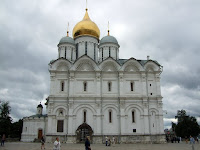 The Kremlin tour took in two of the 6 churches that surround a small square inside the Kremlin walls. One of the members of our group was an ex-bombardier with the American air force who had been in charge of 6 nuclear warheads targeted on the Kremlin and one of our other cruise stops.
The Kremlin tour took in two of the 6 churches that surround a small square inside the Kremlin walls. One of the members of our group was an ex-bombardier with the American air force who had been in charge of 6 nuclear warheads targeted on the Kremlin and one of our other cruise stops.  He said that he had always thought that the only way he would ever see the inside of the Kremlin was from a parachute after having been shot down. We could identify with this feeling as for the first 40 years of our lives, the Kremlin had been associated with all that was antithetical to the western ideals and westerners that entered the Kremlin were in for a tough time.
He said that he had always thought that the only way he would ever see the inside of the Kremlin was from a parachute after having been shot down. We could identify with this feeling as for the first 40 years of our lives, the Kremlin had been associated with all that was antithetical to the western ideals and westerners that entered the Kremlin were in for a tough time. One of the items on display in the Kremlin is the world's largest bell, weighing in at 200 tonnes. Although to call it a 'bell' is stretching the truth just a little as it has never rung, or even had its clapper mounted in it. Shortly after its founding, a fire destroyed the frame holding the bell and it fell to the ground where an eleven tonne chunk broke out of the side of the bell so, in reality, it is the world's largest bell shaped lump of bronze.
One of the items on display in the Kremlin is the world's largest bell, weighing in at 200 tonnes. Although to call it a 'bell' is stretching the truth just a little as it has never rung, or even had its clapper mounted in it. Shortly after its founding, a fire destroyed the frame holding the bell and it fell to the ground where an eleven tonne chunk broke out of the side of the bell so, in reality, it is the world's largest bell shaped lump of bronze.Because of flight schedules we had chosen to leave the tour early so, after lunch,
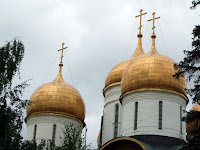 we bade farewell to our companions for the last 10 days and set off to try the Moscow Metro; would that London tube trains operated on the same frequency. The Moscow circle line has trains each way every couple of minutes - a far cry from the Circle Line we are more accustomed too. Of course the London Circle Line has to share the rails with the Metropolitan, Hammersmith & City and District lines so the comparison is not all that fair.
we bade farewell to our companions for the last 10 days and set off to try the Moscow Metro; would that London tube trains operated on the same frequency. The Moscow circle line has trains each way every couple of minutes - a far cry from the Circle Line we are more accustomed too. Of course the London Circle Line has to share the rails with the Metropolitan, Hammersmith & City and District lines so the comparison is not all that fair.There are various Moscow Metro stations that are notable for their platform art or architectural features so we set off on our
 own tour to see a few of them before taking the Metro to the place where the airport shuttle buses terminate. From the centre of Moscow to Domodedovo Airport is a very simple (Green line to penultimate stop, few metres walk to a 380 bus), reasonably quick (75 minute) and certainly inexpensive (79 Rouble) exercise.
own tour to see a few of them before taking the Metro to the place where the airport shuttle buses terminate. From the centre of Moscow to Domodedovo Airport is a very simple (Green line to penultimate stop, few metres walk to a 380 bus), reasonably quick (75 minute) and certainly inexpensive (79 Rouble) exercise.
